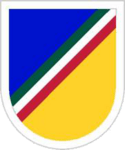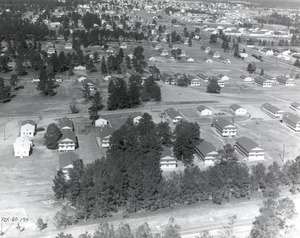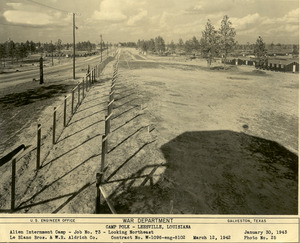Fort Johnson facts for kids
Quick facts for kids Fort Johnson & The Joint Readiness Training Center |
|
|---|---|
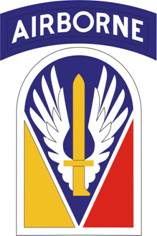
Joint Readiness Training Center and Joint Readiness Training Center Operations Group shoulder sleeve insignia
|
|
| Founded | 1941 |
| Country | |
| Branch | |
| Type | Training post |
| Role | Joint Readiness Training Center |
| Part of | Regular Army |
| Motto(s) | The Home of Heroes |
| Insignia | |
| Beret flash | |
| Background trimming | |
Fort Johnson, once called Fort Polk, is a big base for the United States Army. It's located in Vernon Parish, Louisiana. The base is about 10 miles (15 km) east of Leesville.
This important Army post is named after William Henry Johnson. He was a brave soldier from New York in World War I. The base covers a huge area, about 198,000 acres (800 square kilometers). The Army owns about 100,000 acres. The U.S. Forest Service owns the rest, mostly within the Kisatchie National Forest. In 2013, over 10,000 troops were stationed here. Their salaries added up to nearly a billion dollars a year.
Fort Johnson started as a training area for the Louisiana Maneuvers in the 1940s. It has been home to many different Army units over the years. These include the 1st Armored Division and the 5th Infantry Division. During the Vietnam War, it was a main place for basic training. Today, Fort Johnson is home to the Joint Readiness Training Center (JRTC). It also hosts the 3rd Brigade Combat Team, 10th Mountain Division, and the 115th Combat Support Hospital.
The land around Fort Johnson has many historical and archaeological sites. The U.S. Army has worked hard to find and protect these important places.
The base was originally named after a Confederate general, Leonidas Polk. But on June 13, 2023, it was renamed Fort Johnson. This was done to honor Sgt. William Henry Johnson. He was a hero from World War I who received the Medal of Honor.
Contents
Fort Johnson's History
World War II Training
Building Camp Polk started in 1941. Many wooden buildings were quickly put up. These were for the Army preparing for World War II. Soldiers at Polk took part in the Louisiana Maneuvers. These were big training exercises. They helped prepare U.S. troops for the war.
Before 1939, the Army was mostly made of infantry soldiers. They had some support units like artillery and cavalry. Few units had cars or machines. As the U.S. got closer to joining World War II, the Army needed to become more modern. It also needed large training exercises. This is where Fort Polk and the Louisiana Maneuvers became very important.
The maneuvers involved half a million soldiers. They took place over 3,400 square miles in 1941. The troops were split into two pretend armies. These armies were fighting over river rights. The exercises helped Army leaders test new ideas. They learned how to move large groups of soldiers and machines quickly. After these lessons, 16 armored divisions were created during World War II. These divisions were experts at moving huge combat units over long distances.
The maneuvers also tested a new idea: the tank destroyer. These were fast guns kept ready to fight enemy tanks. They would quickly move to attack enemy tanks from the sides. Tank destroyers used quick hit-and-run attacks. After the war, these special units were stopped. Other Army groups took over the job of fighting tanks.
German Prisoners of War
Camp Polk was mainly a training base. But it also held German soldiers captured during World War II. The first prisoners of war (POWs) arrived in Louisiana in July 1943. They were from the Afrika Korps, who fought in North Africa. They lived in a large fenced area. This area is now Honor Field, the base's parade ground.
It was easier to send prisoners to camps in the U.S. on empty ships. This was better than feeding them in Europe. American soldiers sometimes didn't like that German POWs were in the U.S. But they understood why it was done.
The POWs worked on farms, picking cotton and cutting rice. They also helped cut lumber. They even helped fill sandbags during a big flood in 1944. Prisoners were not forced to work. Those who worked earned special money. They could use this money to buy things like toothpaste or snacks.
After World War II, the base closed and reopened many times. For a while, it was only open in the summers. This was for training reserve soldiers. Soldiers were also stationed there temporarily during the Korean War and the Berlin Crisis.
Training for the Korean War
In August 1950, the 45th Infantry Division came to Fort Polk. They were the first unit to train here for the Korean War. During the war, the 45th Infantry Division had over 4,000 soldiers hurt or killed. They earned several awards for their bravery.
From 1952 to 1954, many units trained at Camp Polk. The 37th Infantry Division helped train them for combat. While the 37th Division itself didn't go to Korea, many of its soldiers were sent there.
Operation Sagebrush
In 1955, the U.S. military held another large training exercise. It covered a big part of Louisiana. This exercise was called Operation Sagebrush. Its main goal was to see how military operations would work in a nuclear war. The exercise lasted 15 days. About 85,000 troops took part. U.S. Air Force planes also joined in, flying over the area.
1st Armored Division Arrives
After Operation Sagebrush, Polk became a permanent base. The 1st Armored Division moved here from Fort Hood. They continued to test new ways to move and fight in the nuclear age. The 1st Armored Division had modern M-48 Patton Tanks and new helicopters. They stayed at Fort Polk until 1959.
Vietnam War Training
In 1962, Fort Polk started training soldiers for basic and advanced skills. A part of Fort Polk has thick, jungle-like plants. This, along with Louisiana's heat and rain, was like Southeast Asia. It helped new infantry soldiers get used to fighting in Vietnam. This training area was called Tigerland. For the next 12 years, Fort Polk sent more soldiers to Vietnam than any other U.S. training base. Many soldiers did their basic training and infantry training at Tigerland. Then they went straight to Vietnam.
In October 1974, the 5th Infantry Division (Mechanized) moved to Fort Polk. Basic training and advanced training slowly stopped. In 1976, the Infantry Training Center at Fort Polk closed. This marked the end of Fort Polk's role in the Vietnam War.
Post-Vietnam Era
After the Vietnam War, Fort Polk changed. It became home to the 5th Infantry Division (Mechanized). This division was reactivated in September 1975. It stayed at Fort Polk until November 1992. The division had two active duty brigades. It also had a brigade from the Louisiana National Guard.
During this time, Fort Polk saw a lot of new construction. New barracks, family homes, and hospitals were built. There were also new stores, classrooms, and sports areas. The Bayne-Jones Army Community Hospital was built. It was named after Stanhope Bayne-Jones, a doctor from Louisiana. He was famous for controlling typhus in Europe after World War II.
JRTC Moves to Fort Polk
In 1993, the Joint Readiness Training Center (JRTC) moved to Fort Polk. It moved from Fort Chaffee, Arkansas. Once again, the base was preparing soldiers for conflicts. Each year, the JRTC trains units before they are sent overseas. In the 1990s, soldiers from Fort Polk went to places like Haiti, Panama, and Bosnia.
2nd Armored Cavalry Regiment
The 2nd Armored Cavalry Regiment came to Fort Polk in 1993. Parts of this regiment went to Haiti in 1995. They also went to Bosnia in 1996. In 2002, the 2nd ACR went to Kuwait and other countries. Then, in 2003, they went to Iraq.
In 2004, the Army announced a change. The 2nd Armored Cavalry Regiment would become a Stryker Brigade. It would move to Fort Lewis, Washington. This move was finished in 2006. Later, the 2nd Stryker Cavalry Regiment moved to Germany.
Current Units at Fort Johnson
Operations Group
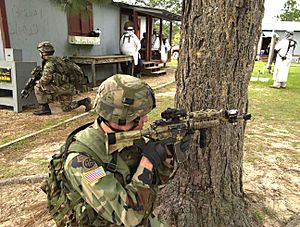
The Joint Readiness Training Center (JRTC) helps units get ready for battle. It provides very real and challenging training. This training covers many types of conflicts. The JRTC is one of the Army's main training centers. It trains infantry brigades and their smaller groups.
The JRTC Operations Group makes training very realistic. Units get to practice joint operations. These often focus on missions they will actually do.
JRTC training includes the Air Force and other military groups. It also uses actors who play local people, rebels, and news reporters. This helps units prepare for real-world situations.
1st Battalion, 509th Infantry Regiment
 |
The 1st Battalion, 509th Infantry Regiment (1-509th IR) plays the role of the enemy. Their job is to act as a challenging opposing force (OPFOR). This gives the units training at JRTC a very realistic combat experience.
3rd Brigade Combat Team, 10th Mountain Division
The 3rd Brigade Combat Team, 36th Infantry Division was activated at Fort Polk in February 2014. It became the 3rd Brigade Combat Team, 10th Mountain Division. This unit was designed to be fast, deadly, and flexible. It can quickly build combat power anywhere in the world. The brigade has its own infantry, cavalry, artillery, and support teams.
This brigade deployed to Afghanistan in 2010. It returned to the U.S. in 2011. From 2016 to 2019, this "Patriot Brigade" was part of the 36th Infantry Division. It later returned to the 10th Mountain Division.
115th Combat Support Hospital
The 115th Combat Support Hospital started as Evacuation Hospital #15 in 1918. It served bravely in World War I in France. It earned an award for its part in the Meuse-Argonne Forest offensive.
The 115th Combat Support Hospital is a medical unit that can be sent anywhere. It provides medical care on the battlefield. This includes surgery, orthopedics, and physical therapy. It also has a pharmacy, X-ray services, and labs. The hospital can be deployed during wars or national emergencies.
U.S. Army Garrison
The U.S. Army Garrison helps run the base. It supports all the units stationed at Fort Johnson. It also helps the units that come to JRTC for training.
Bayne-Jones Army Community Hospital
The main medical center at Fort Johnson is the Bayne-Jones Army Community Hospital. It also includes a Wellness and Readiness Center. The hospital is named after Brigadier General Stanhope Bayne-Jones. He was a famous doctor from Louisiana. He was known for controlling typhus in Europe after World War II.
National Guard Presence
The Louisiana Army National Guard has a maintenance facility at Fort Johnson. This facility helps keep their major units ready. These units include the 256th Infantry Brigade Combat Team and the 225th Engineer Brigade.
Fort Johnson Today
Land Expansion Plans
Fort Johnson has faced the risk of closing several times. In 2008, Fort Johnson started a plan to get more land. The plan is to acquire 100,000 acres. This land is for large JRTC training exercises and live firing. This will be the biggest land expansion since World War II. The first part of the land was bought in 2012.
New Buildings
On November 12, 2014, a new Fort Polk Commissary opened. This is like a grocery store for military families.
Renaming the Fort
On June 13, 2023, the fort was renamed Fort Johnson. It was named to honor William Henry Johnson. He was a brave World War I veteran from New York. He was part of the "Harlem Hellfighters" unit. Johnson was one of the first Americans to receive the French "Croix de Guerre" award. He was later given the Purple Heart and the Medal of Honor. The fort was previously named after a Confederate general. The U.S. Army decided to rename bases that honored Confederate soldiers.
Wildlife Management
A large area of 105,545 acres within the base is a wildlife management area. It is called the Fort Johnson-Vernon Wildlife Management Area. About 700 to 750 feral horses live on the training lands around Fort Johnson. The future of these horses has been discussed since the Army started moving them in 2017.


